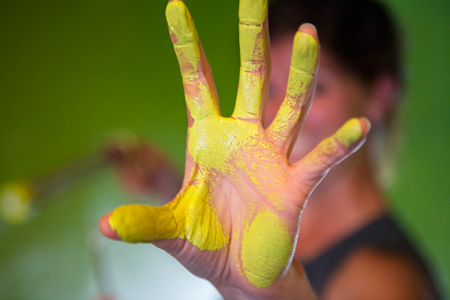We've said good-bye to two more of our fantastic summer interns. We’ll be sharing their stories with you over the next few weeks. It’s been pretty amazing!
What I Did On My Summer Vacation
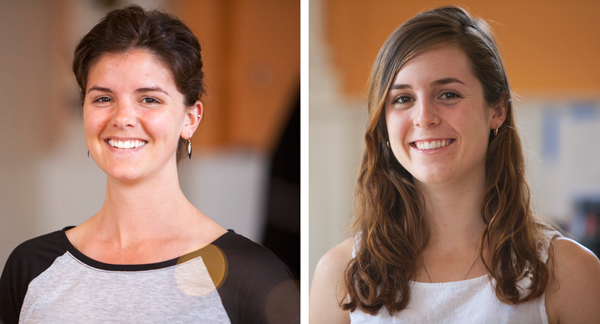
Amy Loomis is a Master’s student at MIT, studying Product Design. Sara Berndt worked on installation art during the summer at both Involution Studios and Anthropologie. She is studying industrial design at Pratt Institute in New York.
Talk about the projects you worked on.
Amy Loomis: I didn’t even really know what part(s) of the software design process Invo was a part of until I started working there in June. I did know, from a visit in January, that the space is like a rough-hewn hipster haven with a serious appreciation for food. Funny enough, no one person who works there seems to fully fit that description. I am a mechanical engineer by training, and product designer by more training (grad student here) so when my projects turned into designing data visualizations and developing an interactive art installation, I was pretty excited for something different from my prior internship experiences.
Sara Berndt: Starting work at Involution for the summer I was asked to work on an entryway display to transition from the “office building” exterior and create a passageway into a creative environment. I wanted the first impression of the space in the studio to establish a sense of awe and welcome at the same time. Working together, Amy and I decided to use the Design Axioms cards, which are so iconic in the studio, and repurpose them to make a display built quite literally on the foundation of the studio values.
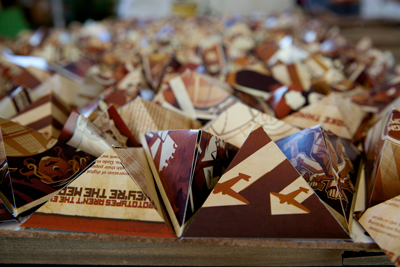
What were some of the most difficult problems you faced?
AL: It’s when you’re actually given freedom at an internship that things get difficult. With somewhat ambiguous projects, particularly the wall installation, it was hard to scope out how long each stage of the process would actually take. For my last week at Invo, I had dreams that I was carrying around a glue gun and making tetrahedrons everywhere I went. (That essentially became the real-life case anyway!) The hardest part about both my projects is looking back at them and wanting a chance to iterate on how I went about working on them. It is well proven that iteration is key in finding an optimal design for any scenario, so having approached both projects with that expectation and time built in for more thorough iteration would have been fruitful. Even so, I’m pretty happy with the results.
SB: The most difficult part of the whole process in my opinion was the space. Working above a stairway posed difficult angles and barely reachable corners. We pushed our patience (and our ladders) to unsafe limits, but in the end we were able to get the whole display up. We have become quite proficient in the art of ladder placement!
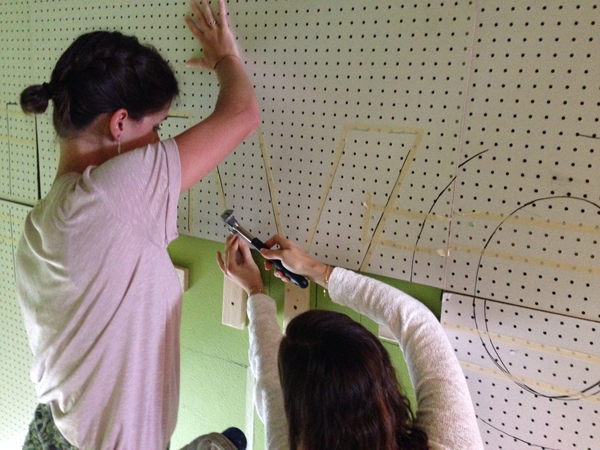
Talk about the studio environment.
AL: How many companies have the capacity to—and then encourage—cooking bacon and eggs for breakfast? One would think more companies would realize how inviting this is as an attribute of a workspace, but this must really still be a secret. My favorite work space for the last couple of weeks was the kitchen table, right where I get my most efficient work done at home as well. With other work options like a couch so big that it makes you feel like a little kid and a color-organized library of design books to peruse and find inspiration from, there’s hardly a reason to take a break for a nerf gun war, but there is abundant opportunity anyway. The studio space reads “fun, quirky, and easily distracted by toys,” yet Invo’s collective portfolio reads “beautiful, intense, and we’re OCD about quality.” Like the bacon and eggs, there has got to be a secret that correlates these resources to their outcomes.
SB: The studio environment is a progressive one. There is a lot of creative nurturing that goes on that I can really appreciate. It’s not about being there to do one job, it’s about bringing your specific set of skills into the mix to benefit the whole. I’ve come to learn that being a designer doesn’t mean just having the skills to design one single entity, it is about having an ingrained creativity to improve what aspects of design interest you.
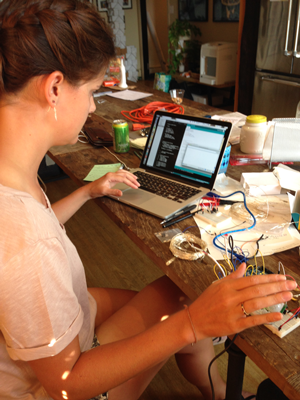
How did your art inform your work?
AL: There is a much more substantial emphasis on sketching here than I expected, which I loved immediately. I don’t think my past artistic endeavors (yes I started drawing unicorns at age 2) informed my projects as much as thinking about conveying complex data in a beautiful and highly accessible way. Whether designing data visualizations or figuring out how to create an interesting and exciting effect with a few thousand Design Axiom cards, the nature of the projects naturally lent them to incorporating “art” in a deliberate and useful way. This was especially cool for me to see: that the added value of aesthetic intent is so substantial on top of a digital or a physical structure.
SB: As an industrial designer I am often thinking about my user. What kind of person will use my product and what will their experience be? The entryway display was not unlike this thought process, as I had to imagine the user experience and how they interacted with the installation. In the end Amy and I wanted the guest to feel like the display was almost personalized as they entered, lighting up at their arrival to reveal the Invo text.
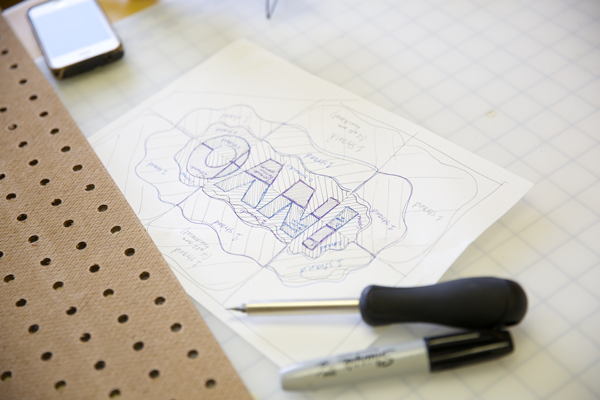
Were you breaking new artistic ground for yourself at Involution?
AL: As an engineering student for the past five years, the majority of my “artistic ground” has looked like nicely gridded, green engineering notebook paper. That’s not to say I don’t love stepping back and sketching for a few hours, but this was the first time I was effectively commissioned to be an artist—and it was especially scary in that capacity! Particularly so when just about everybody in the studio was helping us really assemble our installation. It was especially great to work collaboratively on this design with Sara (it was initially her project and I totally shoved my way into working on it). I have never had the chance to do a “group art project” in any real capacity before, so it was a cool artistic experience from that perspective alone.
SB: I’ve definitely never worked as large as I did at Invo this summer! I learned a lot about space and planning when it comes to large displays and how to use materials in unconventional ways. This has changed a lot of how I think about the design process as well, specifically prototyping, which Invo helped me accomplish more successfully.
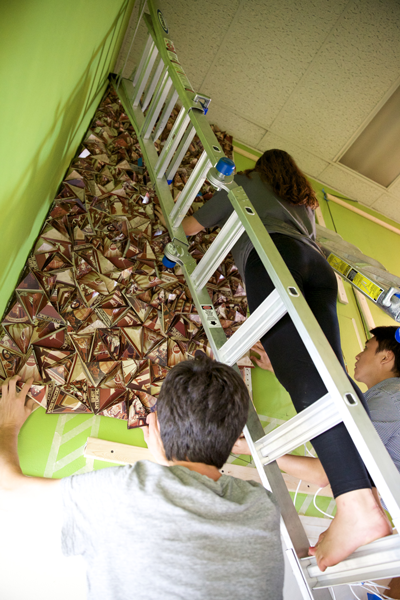
Final thoughts? What will you take with you from this experience?
AL: I’m so glad I bothered Juhan about the possibility of an internship with him this past spring. I had known him and Sarah Kaiser after working with them at MIT in the fall of 2013, and I had a good feeling that the human aspect of Invo would be pretty great, judging by those two. Invo has a pretty cool gig happening with the people there. It’s quite obvious that everybody loves working there; the environment is hardly just about the work. Invo hires humans, not just the skills they use during working hours, and it has been really great to learn from these people, about them personally and about their skills too.
SB: As long as you are flexing that creative muscle I think anything you do has significance and learning value. Art installations are not my professional creative field per se, but the experience I gain from such projects is often more rewarding than the ability to carry out the process. I can apply the lessons I learned being a part of the design and building to all aspects of my creative education and become a more well-rounded and experienced designer because of it. Meeting new people along the way is also a big plus. I’ve met so many interesting people with so much passion for the work they are doing—it’s hard not to get excited about it along with them!
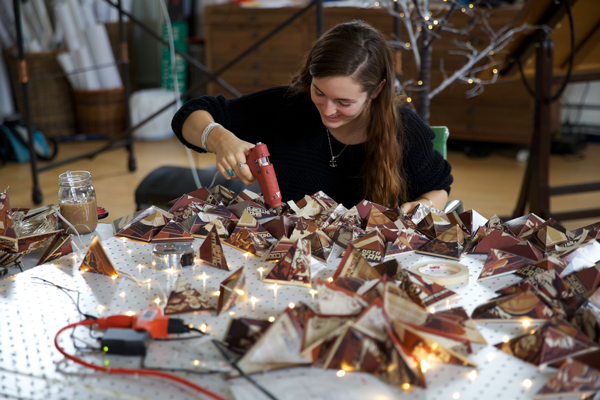
Thinking about joining Involution Studios as an intern? Learn more!
